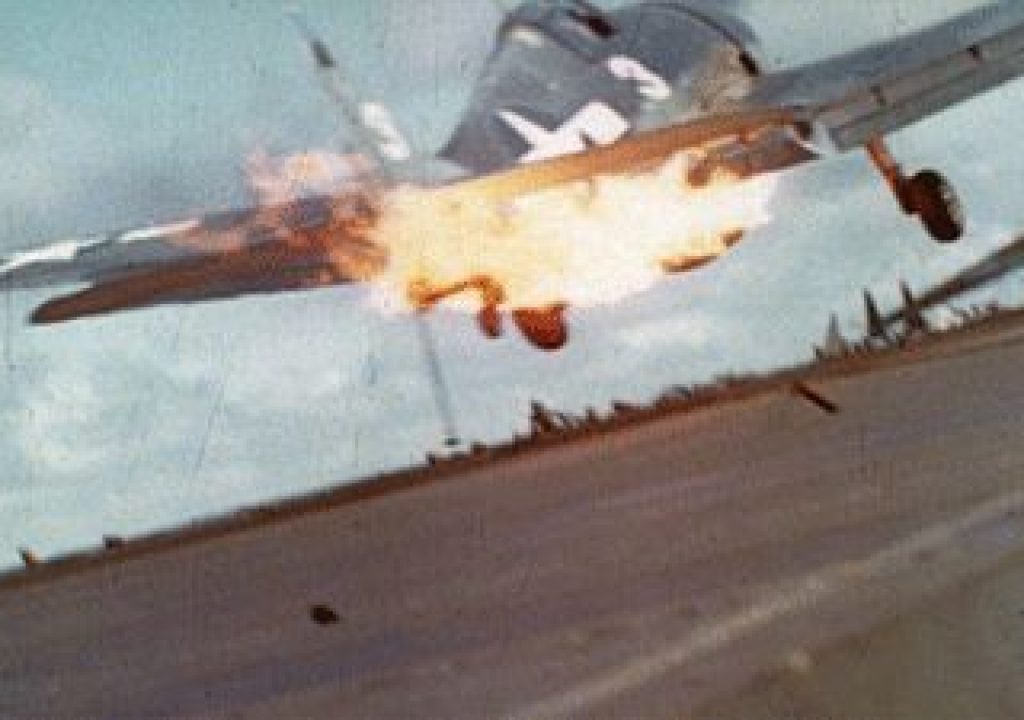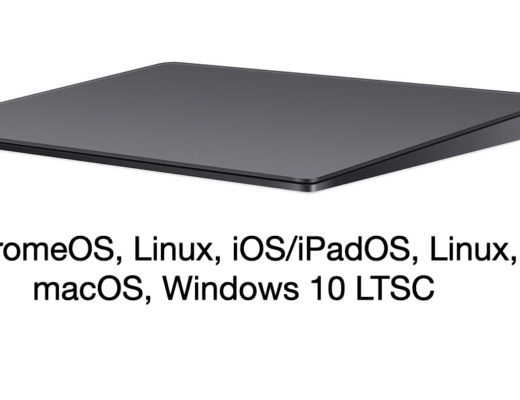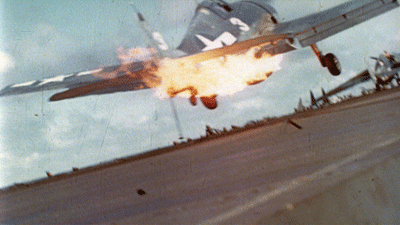
?The History Channel’s WW2 in HD series has created a firestorm of debate over archival methods.
If you read the AMIA listserve, the Cinematographer’s Mailing List, or the Telecine Internet Group or TKColorist Internet Group listserve, chances are you saw the huge debate over how the huge amount of rare color footage from World War II was transferred. Many people thought that historical records were being destroyed by careless film transfers. Several web stories – that were actually created by publicists – supported this controversy, but turned out to be mis-information.
The true story of the making of the series turns out to be far more interesting than the fiction, as so often is the case. I interviewed the series’ director, Frederic Lumiere on the phone in the midst of the controversy and discovered a man passionate about his project and for the care and cataloging of the materials he oversaw. Any misquotes can be attributed to my transcription. I recorded the entire interview and did the transcription word for word, but phonetic transcription is contextual and between Mr. Lumiere’s mild French accent and the quality of the phone line audio, I may have made minor mistakes. My intent was to be honest and portray the events correctly.
This interview covers three interesting aspects of this massive project: the film transfers of the archival color footage – including the novel use of Lumiere’s RED camera – the creation and use of a database to keep track of 3,000 hours of archival footage, and the editing concept that delivered emotional impact on top of historical factuality.
Because this is kind of “breaking news” item, what follows is a transcription of our interview with no additional information or clean up.
PVC: Tell me about the process of getting all of this rare 35mm and 16mm film footage to a broadcastable form.
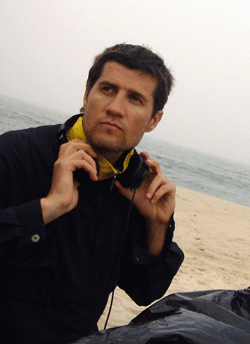 Frederic Lumiere: Well the first thing we did was we really spent about a year to find every piece of color footage from the 1940s that we could. The sources came from the National Archives, the Marines, the Navy, from other countries, from World War Two museums, you name it. If the source had World War Two footage, we got access to it. And that took betweek 10 to 12 months to do that and the way we processed the film all depended on the source. For example, the National Archives – only certain companies are allowed to work with the film and so we enlisted one of these companies to process the things wanted. And what they used was a C-Reality Hi-res scanner, (CORRECTION – HENNINGER used a Spirit) which scans the film frame by frame. And it was delivered to us just uncompressed high definition video as Quicktime on hard drives. In Europe, we used another company that is approved by a lot of the archives that are there and they would use Cinetel scanner, I believe which does similar things as the C-Reality. So between these two sources, I would say we got 1200 hours, 1100 hours of footage. Through the National Archives, one of the ways we did it is we had a guy who virtually lived there, who basically shot the film off the projection at the National Archives and we used these as sceeners so to speak to evaluate what we wanted and what we didn’t want. It was just a really cheap (Sony HVR) Z1U or something like that. And that was just to document “This is what’s available.” Keep in mind that with 2500 to 3000 hours for an editing team of 21 to 22 editors when it all comes down to it plus researchers, plus producers and writers and so forth on a SAN, that required 22 to 24 terabytes, I can’t even remember.
Frederic Lumiere: Well the first thing we did was we really spent about a year to find every piece of color footage from the 1940s that we could. The sources came from the National Archives, the Marines, the Navy, from other countries, from World War Two museums, you name it. If the source had World War Two footage, we got access to it. And that took betweek 10 to 12 months to do that and the way we processed the film all depended on the source. For example, the National Archives – only certain companies are allowed to work with the film and so we enlisted one of these companies to process the things wanted. And what they used was a C-Reality Hi-res scanner, (CORRECTION – HENNINGER used a Spirit) which scans the film frame by frame. And it was delivered to us just uncompressed high definition video as Quicktime on hard drives. In Europe, we used another company that is approved by a lot of the archives that are there and they would use Cinetel scanner, I believe which does similar things as the C-Reality. So between these two sources, I would say we got 1200 hours, 1100 hours of footage. Through the National Archives, one of the ways we did it is we had a guy who virtually lived there, who basically shot the film off the projection at the National Archives and we used these as sceeners so to speak to evaluate what we wanted and what we didn’t want. It was just a really cheap (Sony HVR) Z1U or something like that. And that was just to document “This is what’s available.” Keep in mind that with 2500 to 3000 hours for an editing team of 21 to 22 editors when it all comes down to it plus researchers, plus producers and writers and so forth on a SAN, that required 22 to 24 terabytes, I can’t even remember.
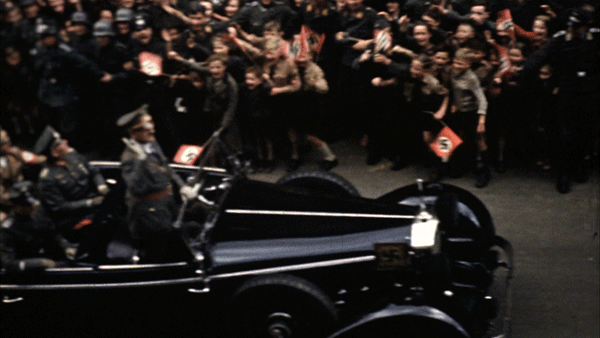
So the whole series is actually edited in DV and a lot of that screener footage actually didn’t look that good. There was only so much time to document the footage that the gentleman who was at the National Archives would shoot the footage as it was being projected by a National Archives employee and sometimes you’d see his face in a reflection and it was shot from an angle. But that footage was just to see what was in color and what we had. And then, once we made a cut we would go out to the National Archives and place and order and the reels would then be sent to a company approved by NARA – the National Archives – and they would send us hard drives. Now with the Marines and the Navy, we’d also get a lot of that stuff because of Lou (Scott) Reda’s connections, directly from them and a lot of them were prints and so forth and for those we used the RED to capture the footage in a telecine configuration from an older telecine machine, but a really good one. (CLARIFICATION: It seems Mr. Lumiere means that they used a film chain or multiplexer for a film chain, probably by RCA, which used to use an Ikegami camera. This is somewhat different from a modern telecine.)
PVC: Who exactly was this company that you used to transfer the film that the National Archives approved?
FL: I think they’re called Prelinger? (CORRECTION: This is a mis-transcription. The work was done at Henninger. They also used Bono Labs in Washington, D.C. and Ascent Media who used a C-Reality.)
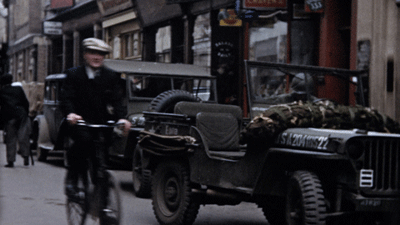 PVC: How was this footage saved to disk? With what codec?
PVC: How was this footage saved to disk? With what codec?
FL: We started out doing it uncompressed Quicktime, but quickly realized that we needed to switch to ProRes HD 4:2:2.
PVC: Can you describe the RED used in telecine configuration a little better?
FL: We had a telecine machine that has been used for many, many years and the RED camera is mounted in place of the original camera. I think we had an Ikegami there before. In a virtual, dark environment the RED shoots the film. Now, all of that film, first looks fantastic, because the RED captures every little detail of the film, probably not as good as a scanner, but this way we were able to capture every little piece of film from the Marines and the Navy. And one of the things that I said in a previous interview, I said some of the film fell apart when it was projected only once. That was in reference to some 8mm home movies that were from families who had kept the film in boxes. First of all most of that film was not even used (in the final production). It was a wedding or it was…really it was not that big of a deal. The film is still there, we just kind of have to patch it back together, but I think it happened on only one reel to be honest with you and the whole controversy started from this statement about a minute of film when we dealt with virtually 3,000 hours of footage.
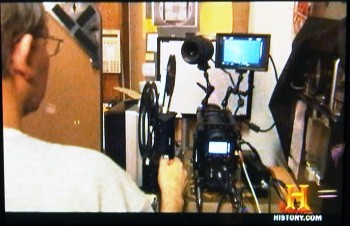 PVC: And how did you transfer the 8mm stuff?
PVC: And how did you transfer the 8mm stuff?
FL: Through an 8mm projector right onto the wall. And it looked great. A lot of it was in Episode One when we do Pearl Harbor and you see all the home movies. That’s from that.
PVC: What was the process of allowing your producers and editors to find and look through all of this material?
WWII in HD – RAVE REVIEWS from Frederic Lumiere on Vimeo.
FL: Here’s another interesting and very positive aspect of what we’ve done. One of the things we did was – for the National Archives for instance. The National Archives is massive! There is a massive amount of footage there. So one of the things we did was there’s only so much they can do with the logging. Now a lot of the logging is fine and it’s good, but a lot of it is either inaccurate or incomplete, and one of the things that we realized we needed to know, is that we needed to know every single piece of — Well, a good editor needs to know his content and a good producer needs to know his content, but when you’re talking about this much footage, there’s only so much you can get from the source that is sort of what is in those reels. And so, we had a virtual army of interns and researchers who looked at every frame of every film and logged it into a database. And the way we did that was that the RED camera would go to a RED file, but simultaneously, we’d go to an MPEG H.264 clip that would be useable by the database. So what this allowed us to do was, we then had a database, that was a networkable database that was accessible by every team player, where you could essentially go to the database – a FilemakerPro database – and type a query and say “Navy, air craft carrier, bombs.” And all of a sudden you’d have 35 entries that would come back from the query and each entry, not only can you read the entry at that point, but you can also view the clip realtime.
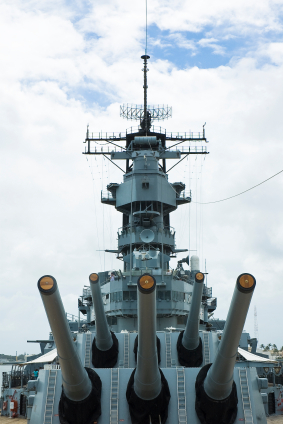 PVC: So the MPEG-4s are part of the database?
PVC: So the MPEG-4s are part of the database?
FL: Yes. They are being pulled by the Filemaker database from a directory that is linked to it and so the video clip will show up as you’re reading the log, so that was incredibly beneficial to the writers and producers and the editors to some extent, and the assistant editors because you could do some very detailed searches. You could go “Grenade launcher, Terawa, Marine, camel helmet” and out of those 3,000 hours of footage you’d be able to see there are three entries and here are the timecode entries where you can find those. That really helped us because one of the big challenges of this show was, because we kind of created a new genre. I know you said you were an editor and a lot of editors had a hard time with this show because it was very counter-intuitive editing for a documentary editor. Let me explain this. A documentary editor is trained to tell a story visually, the best he can with b-roll. That is really the first approach. So you find the best possible footage to illustrate what’s being told. Well that doesn’t work in this show. In this show, it’s a very different aim. In this show, what you want to do is create an experience which means sometimes you may have to give up a great shot if the shot is not compatible with the previous one, because you want to create these scenes that feel like an experience. So that means that you may need for instance, you need everything you can get your hands on of a ship in rough seas, and now you can start stitching those clips together that feels like it was shot by a cinematographer who was there to shoot a film and that is usually what I would tell the editor: “So if you were Michael Bay and you were going to cover the bombing of Tarawa, how would you do it?” You’ve seen the films. You know how they do it. With multiple camera angles. From the air. From the ground. From the right. From the left. You show the same explosion two or three times. That’s how we need to cover it. We need to create the illusion that this is an epic Hollywood feature. And that requires a incredible access to your footage and being very intimate. But no one can be intimate with 3,000 hours of footage.
PVC: How was the database able to reference the MPEG4 files? Can you actually embed MPEG4 into Filemaker?
FL: Yes you can. You just open a movie window and design it and have a regular path that is always the same and it will pull it right up. You just have to have a good naming convention so you know what you expect the film to be named, but it will come right up.
PVC: And this was placed on a large SAN or something so you’ve got 20 or 22 editors, plus producers and writers and everyone has access to this same database?
FL: Exactly.
PVC: Wow. That’s a great story. And I love the idea of a creating a documentary where you’re not trying to simply reference old footage in telling a historical story, but to use the footage as if you were creating a fresh, modern feature film where you are able to shoot exactly what you want, but since the event is past, you recreate that feeling of coverage as if you were trying to shoot this today.
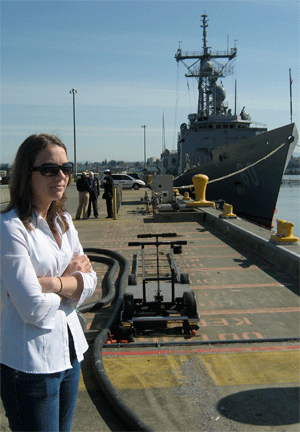 FL: I’ll give you an example, when we did Pearl Harbor it’s a perfect example. I’m sitting with Liz Reph (PICTURED TO THE RIGHT) – who’s one of the greatest producers in the business in my opinion. She’s done tons and tons of war documentaries. – and one of our lead editors, Sammy Jackson – Now you have to understand with Sammy Jackson, he has probably done Pearl Harbor 30 times already in different shows. Sammy Jackson has probably done every battle…you name a battle and he’s done it at least a half dozen times. So we’re sitting around a table with Sammy and Liz and we’re talking about Pearl Harbor. We have a good script here, but how are we going to cover it? How are we going to make Pearl Harbor feel verydifferent from the way it’s ever been treated before or any way you’ve ever done it, Sammy? So we’re brainstorming back and forth and then we come up with the idea of, “Think about 9/11. Everybody has a story about how they found out about 9/11, because it was such a traumatic and important moment in the American psyche. You’ll never forget about where you were when you found out about 9/11.” And then we started thinking about, back then – people’s stories about today about 9/11, they say “At first I thought it was a movie.” I was in Italy when 9/11 happened and I turned on the TV and I thought it was some Hollywood movie, so then there was this sense of realization. And today everything is instant you have the internet and CNN, but still the information is not complete. “Was it a plane? Was it a bomb? Was it a terrorist attack?” So we realized back in the 1940s it was probably very much like that. How did people find out about Pearl Harbor. So we tried to recreate those couple of days from 7am till night time when radio reports start coming in on the East Coast and West Coast, San Francisco, L.A. and how did people react? The slow spread of the panic. And we realized, here is the fresh way to show Pearl Harbor. Not only a really fresh way, but a really good way for people to really relate.
FL: I’ll give you an example, when we did Pearl Harbor it’s a perfect example. I’m sitting with Liz Reph (PICTURED TO THE RIGHT) – who’s one of the greatest producers in the business in my opinion. She’s done tons and tons of war documentaries. – and one of our lead editors, Sammy Jackson – Now you have to understand with Sammy Jackson, he has probably done Pearl Harbor 30 times already in different shows. Sammy Jackson has probably done every battle…you name a battle and he’s done it at least a half dozen times. So we’re sitting around a table with Sammy and Liz and we’re talking about Pearl Harbor. We have a good script here, but how are we going to cover it? How are we going to make Pearl Harbor feel verydifferent from the way it’s ever been treated before or any way you’ve ever done it, Sammy? So we’re brainstorming back and forth and then we come up with the idea of, “Think about 9/11. Everybody has a story about how they found out about 9/11, because it was such a traumatic and important moment in the American psyche. You’ll never forget about where you were when you found out about 9/11.” And then we started thinking about, back then – people’s stories about today about 9/11, they say “At first I thought it was a movie.” I was in Italy when 9/11 happened and I turned on the TV and I thought it was some Hollywood movie, so then there was this sense of realization. And today everything is instant you have the internet and CNN, but still the information is not complete. “Was it a plane? Was it a bomb? Was it a terrorist attack?” So we realized back in the 1940s it was probably very much like that. How did people find out about Pearl Harbor. So we tried to recreate those couple of days from 7am till night time when radio reports start coming in on the East Coast and West Coast, San Francisco, L.A. and how did people react? The slow spread of the panic. And we realized, here is the fresh way to show Pearl Harbor. Not only a really fresh way, but a really good way for people to really relate.
PVC: Right. And to get the emotion into it.
FL: That’s right. It makes me remember how I felt when I found out about 9/11. Because what we want to do is really make people feel. This could have been you and this is how they felt. They were real people, in color, not black and white, who had real feeling, real lives that were really impacted. And that’s why I think the show is so powerful, because we really made an effort to bring you back to that emotional state. So hopefully we were successful.
So that’s the interview. Please feel free to comment on this story and continue the debate over the best-practices of archival transfer and if you were part of the debate, please feel free to link this article to those who may have been arguing with the wrong set of facts.
The series is being rebroadcast right now on the History Channel. Check it out for yourself.
http://www.history.com/content/wwii-in-hd
By the way, the entire series was cut using Final Cut Pro and Edit Share and the color correction was done in house using Apple Color. I’ve only seen the color correction on web-compressed images so I’ll have to hold my criticism of the color correction done in-house. Some of the comments in the threads I read (especially on the colorist list) were not complimentary.

Filmtools
Filmmakers go-to destination for pre-production, production & post production equipment!
Shop Now